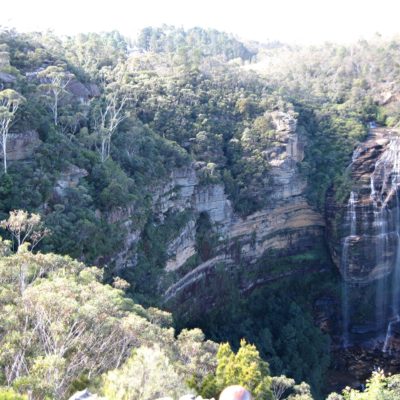The Greater Blue Mountains Area is one of Australia’s many natural heritage sites. Easily accessible from Sydney, a visit should not be missed.
On my last vacation down under, I only had three days in Sydney and was a little iffy about spending one of those on a trip inland. I was rather tempted to spend the day on the coast, but on the other hand I had wanted to visit the Blue Mountains for a long time. In the end, my ambition to visit as many UNESCO World Heritage Sites (WHS) as possible got the better over my desire to spend time at the beach. I think this was a good decision.
The Greater Blue Mountains Area can be reached from Sydney in about an hour by car and there are also many tours available, so there really is no excuse not to spend at least a few hours there. I was quite overwhelmed by the sheer size of the eucalypt woods – there seems to be no end to them. Walking through, you feel lost in a wilderness, despite the knowledge that urban life is close by. Standing on the edge of cliffs of up to 300 metres height, overlooking the vast bluish-green mass of eucalypt, you cannot imagine a village or town to be close by, let alone a huge city like Sydney.
- Blue Mountains – Panorama -2-
- Blue Mountains – Wentworth Falls
- Blue Mountains – Three Sisters -2-
- Blue Mountains – Railway
According to the site’s description on the UNESCO World Heritage website, the area is so important because it
‘(…) is noted for its representation of the evolutionary adaptation and diversification of the eucalypts in post-Gondwana isolation on the Australian continent.’
The Greater Blue Mountains Area WHS is actually comprised of eight different sites: seven national parks and a karst conservation reserve, to a total of 1.3 million hectares. According to the UNESCO’s description mentioned above,
‘it constitutes one of the largest and most intact tracts of protected bushland in Australia’,
and is home to 152 plant families, 484 genera and c. 1,500 species – you can find ‘a significant proportion of the Australian continent’s biodiversity’ here. Yet, even if you’re not into biology or the evolution of the planet, the area is breathtaking and makes for an amazing day out.
- Blue Mountains – Three Sisters -1-
- Blue Mountains – Lyre Bird
- Blue Mountains – Aboriginal Art – Kangaroo
When we stopped for lunch in a small town, I was reminded of a passage from Bill Bryson’s Down Under, in which he states that visiting small towns in inland Australia he felt transported back to the 1950’s. I found some of that nostalgic feeling here, as well, with a well-maintained high street, little shops here and there, cafes and restaurants, trees to offer shade along the walkways and hardly any traffic. It seemed like a place you’d like to spend time strolling or sitting around, not like a lot of towns nowadays, where there aren’t any little shops anymore, hardly any eateries or places to sit. This really felt like a nice change from urban concrete, despite being an urban setting itself – just much more alluring and comfortable.
I also rather enjoyed a trip to Scenic World Blue Mountain, where you can go on the world’s steepest railway (scary!), walk through Jurassic rainforest on the Jamison Valley floor and also have a choice between a skyway and cableway. Our group went down into the valley on the railway, then for a walk followed by a cableway trip across the gorge to a viewpoint from which you have good views of the famous rock formation known as the Three Sisters. What really made my day, though, was seeing a lyre bird. They are said to be extremely shy and I hadn’t expected to see – or hear – one. Unfortunately, it kept moving around, so that I wasn’t able to take a decent photograph.
In sum, I can only recommend a visit to the Blue Mountains. If you have the time, you should probably stay for a few days.









That first picture is gorgeous. Makes me want to pack my bags and go!
Mission accomplished, then! =) Thank you!
The Blue Mountains are really worth a trip and I think it would be quite nice to spend more than just a day there.